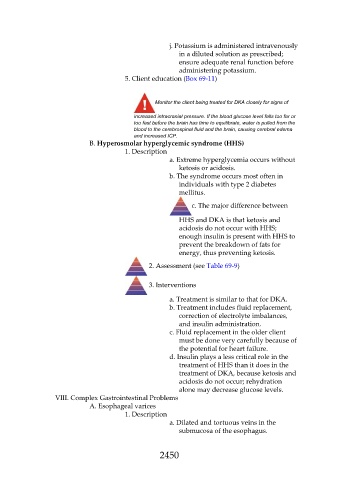Page 2450 - Saunders Comprehensive Review For NCLEX-RN
P. 2450
j. Potassium is administered intravenously
in a diluted solution as prescribed;
ensure adequate renal function before
administering potassium.
5. Client education (Box 69-11)
Monitor the client being treated for DKA closely for signs of
increased intracranial pressure. If the blood glucose level falls too far or
too fast before the brain has time to equilibrate, water is pulled from the
blood to the cerebrospinal fluid and the brain, causing cerebral edema
and increased ICP.
B. Hyperosmolar hyperglycemic syndrome (HHS)
1. Description
a. Extreme hyperglycemia occurs without
ketosis or acidosis.
b. The syndrome occurs most often in
individuals with type 2 diabetes
mellitus.
c. The major difference between
HHS and DKA is that ketosis and
acidosis do not occur with HHS;
enough insulin is present with HHS to
prevent the breakdown of fats for
energy, thus preventing ketosis.
2. Assessment (see Table 69-9)
3. Interventions
a. Treatment is similar to that for DKA.
b. Treatment includes fluid replacement,
correction of electrolyte imbalances,
and insulin administration.
c. Fluid replacement in the older client
must be done very carefully because of
the potential for heart failure.
d. Insulin plays a less critical role in the
treatment of HHS than it does in the
treatment of DKA, because ketosis and
acidosis do not occur; rehydration
alone may decrease glucose levels.
VIII. Complex Gastrointestinal Problems
A. Esophageal varices
1. Description
a. Dilated and tortuous veins in the
submucosa of the esophagus.
2450

